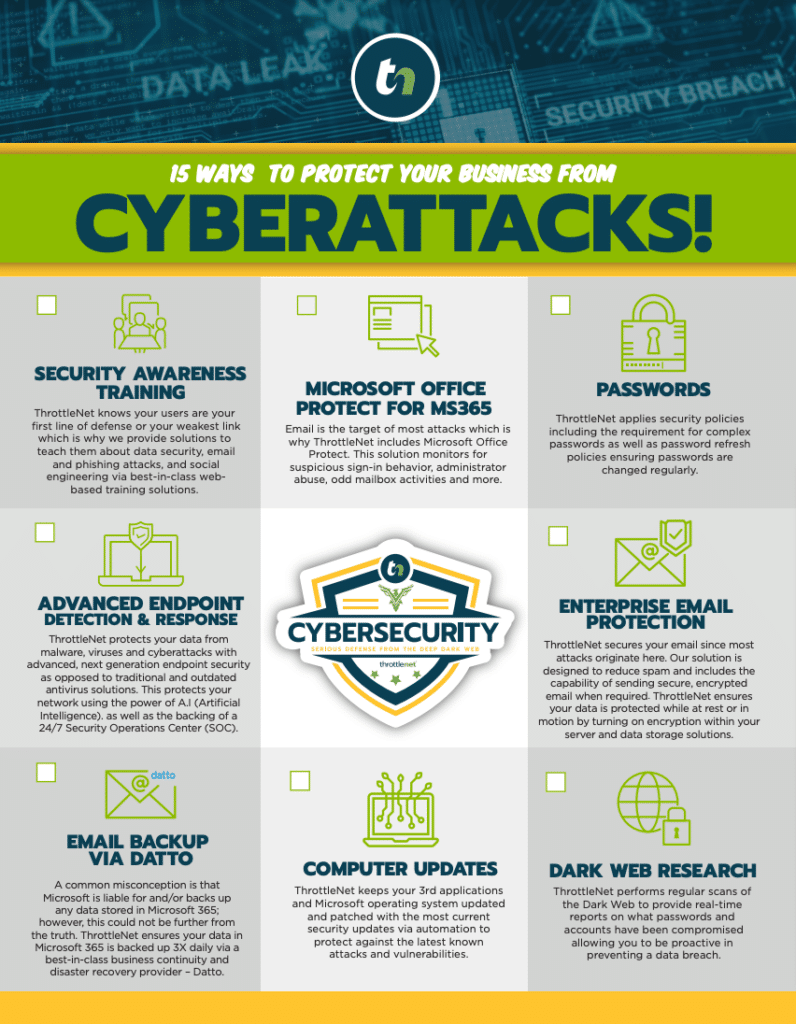It used to be you could install a name-brand antivirus/antimalware software and feel confident in your protections; however, today’s businesses face a new threat – Advanced Persistent Threat Protection. These are stealthy, long-term cyber intrusions designed to steal data, disrupt operations, and go undetected for months or even years.

For small to medium-sized businesses (SMBs), APTs pose a serious risk. Many SMBs believe they are too small to be targeted, but cybercriminals increasingly focus on SMBs due to their typically weaker security measures. Failing to detect an APT early can lead to significant financial losses, reputational damage, and even business closure.
Let’s break down the importance of identifying APTs, how they infiltrate networks, and the devastating impact of undetected threats on SMBs.
What is an Advanced Persistent Threat (APT)?
An Advanced Persistent Threat (APT) is a long-term, targeted cyberattack where an attacker gains unauthorized access to a network and remains undetected while stealing data, monitoring activity, or preparing for a larger attack.
Key Characteristics of APTs:
• Stealthy & Persistent: APTs operate quietly for months or years without detection.
• Highly Targeted: Unlike random malware, Advanced Persistent Threats focus on specific businesses, often in finance, healthcare, legal, and tech sectors.
• Multi-Stage Attack: APTs start with initial infiltration (phishing, malware, or credential theft), then expand laterally across the network.
• Continuous Data Theft: Attackers exfiltrate customer records, financial data, intellectual property, or credentials.
Common Attackers Behind APTs:
• Nation-State Hackers – Target businesses for economic espionage.
• Cybercriminal Groups – Steal sensitive data for financial gain.
• Competitors – Some attacks are business-driven to steal trade secrets.
How APTs Infiltrate SMB Networks
Cybercriminals use multiple techniques to enter a network, stay hidden, and maintain control over time. Here’s how they do it:
1. Spear Phishing & Social Engineering
What Happens? Attackers send highly targeted, realistic-looking emails to trick employees into clicking malicious links or entering login credentials.
Example: An employee receives an email pretending to be from Microsoft IT, asking them to “reset their password” – unknowingly, they hand over credentials to the attacker.
2. Exploiting Unpatched Software & Zero-Day Vulnerabilities
What Happens? Attackers scan for unpatched software, outdated operating systems, or zero-day vulnerabilities (unknown flaws with no fix yet).
Example: A company using an outdated VPN appliance fails to patch a critical security flaw, allowing hackers to gain remote access to the network.
3. Credential Theft & Privilege Escalation
What Happens? Once inside, attackers steal passwords and escalate privileges to gain access to more sensitive systems.
Example: A hacker brute-forces weak administrator passwords and gains full control over the network—stealing customer payment data and employee payroll records.
4. Lateral Movement & Data Exfiltration
What Happens? APTs slowly spread through the network, searching for valuable data while remaining undetected.
Example: The hacker moves from one compromised device to another, infecting backup systems, servers, and cloud accounts before exporting gigabytes of sensitive data.
The Impact of Undetected Advanced Persistent Threat on SMBs
APTs don’t just cause one-time damage—they create long-term consequences that can cripple an SMB.
1. Financial Losses & Extortion
Direct Costs:
- Ransom payments (if the APT deploys ransomware).
- Regulatory fines for leaked customer data.
- Legal fees & lawsuits from affected customers or partners.
Indirect Costs:
- Loss of business revenue due to operational disruptions.
- Increased cyber insurance premiums after an attack.
Example: A small law firm experiences a silent breach for six months, leading to client legal files being sold on the dark web, triggering lawsuits and compliance fines exceeding $500,000.
2. Reputational Damage & Loss of Customer Trust
- Loss of Business Partnerships – Clients and vendors may terminate contracts over security concerns.
- Negative PR – If sensitive customer data is leaked, word spreads quickly, damaging trust.
- Regulatory Violations – Businesses in healthcare (HIPAA), finance (PCI DSS), or government contracts (CMMC) face steep fines for failing to protect sensitive data.
Example: A medical clinic unknowingly leaks patient health records after an APT exfiltrates HIPAA-protected data. The breach costs them $250,000 in compliance fines and multiple patient lawsuits.
3. Business Disruption & Downtime
- APTs can corrupt systems, delete files, or install backdoors for future attacks.
- Some APTs deploy ransomware at a later stage, locking SMBs out of their own systems.
Example: A manufacturing company loses access to its entire production system after an APT encrypts its servers. Downtime costs $100,000+ per day in lost orders.
How SMBs Can Detect & Prevent APTs
Preventing APTs requires advanced threat detection, proactive monitoring, and cybersecurity best practices.
1. Implement Advanced Threat Detection (MDR/XDR)
- Deploy Managed Detection & Response (MDR) to detect suspicious behavior.
- Monitor unusual login patterns and data transfers.
2. Enforce Zero Trust Security & Multi-Factor Authentication (MFA)
- Adopt a Zero Trust framework
- Verify every user, device, and connection.
- Require MFA for all accounts, especially admin access.
- Limit user permissions with least privilege access (LPA).
Example: Even if a hacker steals credentials, MFA blocks access without a second verification factor.
3. Patch & Monitor Systems Regularly
- Automate software updates and patch vulnerabilities immediately.
- Conduct monthly penetration tests to check for security gaps.
- Use Security Information & Event Management (SIEM) tools for real-time monitoring.
Example: Preventing an Advanced Persistent Threat by patching a known exploit in a VPN before hackers can use it.
4. Train Employees on APT Awareness
- Conduct regular phishing simulations.
- Teach employees how to spot social engineering attacks.
- Encourage a “report anything suspicious” security culture.
Fact: 91% of APTs start with a phishing attack—training employees can prevent most breaches before they happen.
Why SMBs Must Take APTs Seriously
APTs are not just a “big business” problem—SMBs are becoming the top targets for these stealthy cyberattacks.
Without proactive detection and security measures, an SMB could lose hundreds of thousands in stolen data, downtime, and legal fees.
Investing in advanced threat detection, Zero Trust security, and employee training drastically reduces the risk of a catastrophic breach.

Chris Montgomery
ThrottleNet Sales Director
[email protected]



